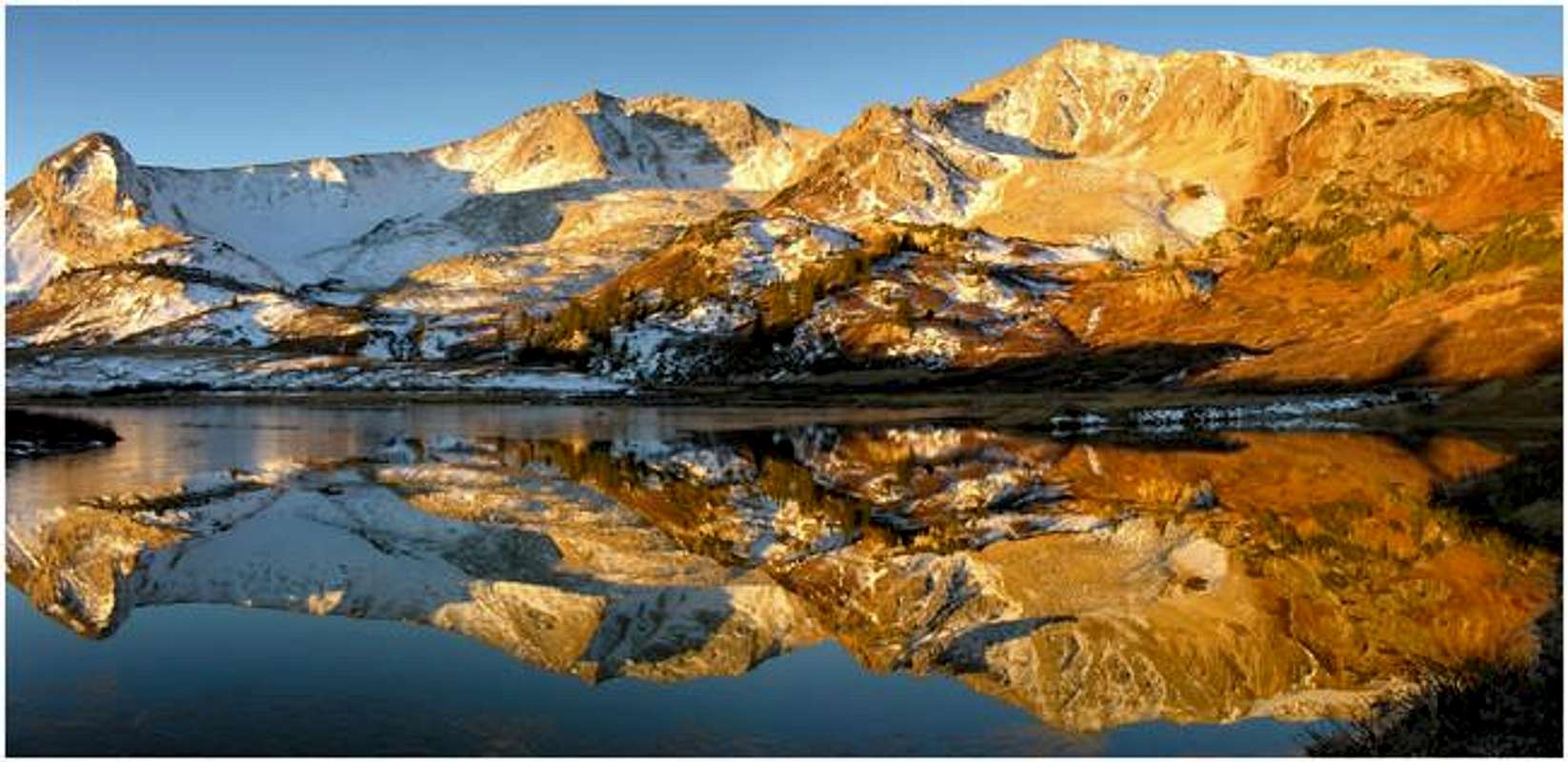|
|
Mountain/Rock |
|---|---|
|
|
38.94560°N / 106.7525°W |
|
|
13379 ft / 4078 m |
|
|
The Elk Range

The high mountains of Colorado’s Elk Range are among the finest peaks in the Rockies. With Wilderness designation, these protected mountains are rugged, steep and aesthetically pleasing. Crystal clear streams, pristine alpine lakes and lush green vegetation are common sights.
The Elk Range can be sectioned into three sub ranges, the Central Elks (Maroon Bells, Capitol Peak/Snowmass Mountain, and the Conundrum/Castle Creek), the Raggeds (Chair Mountain, Ragged Mountain and the Treasure Mountain massif) and the West Elks (the Beckwith’s, the Owens Mountain massif, West Elk massif and the Anthracite Range.)
The scenic beauty of the Elk Range is mostly due to its unique geology. There are two very distinct geological types of rock that are clearly evident in the Elk Mountains, the tertiary intrusives, and the stratified sedimentary. The whitish, gray rock of the tertiary intrusives is responsible for the sweeping, skinny ridges that connect point-to-point, evident in Snowmass Mountain, The Beckwith’s, Capitol Peak and the Chair Mountain massif. Second, the stratified purplish-red, sedimentary rock of the Permian age, evidenced in mountains like Cathedral Peak, Teocalli Mountain, Pyramid Peak, Maroon Bells and UN13,336.

Over the years, the Elk Range has have remained in respectably good shape. Thanks to the Maroon Bells Snowmass Wilderness, we can visit large sections mountainous terrain knowing not much has changed since early exploration.
The Elk Range has a slight reputation for difficult and dangerous climbing due to the loose and crumbling nature of the prevalent geology. Most of the prominent high peaks in this range require solid route finding and climbing skills. If you choose to spend time hiking and climbing the Elks, expect a different experience every time out. The experiences here can be good or bad. It could be an experience you won’t ever forget, or an experience that you want to forget, but can’t.
Italian & Lambertson Overview

The officially ranked Italian Mountain (13,379-ft) and the unranked Lambertson Peak (13,209) reside within the Elk Range boundary northeast of Taylor Park Reservoir and southwest of Pearl Pass. Italian Mountain is Colorado’s 337th highest mountain and has a respectable 1,358-ft of prominence. Along with American Flag Peak these mountains form their own massif, the Italian massif.
Isolated from the central backbone of the Elk Range proper, the Italian massif somewhat resides by itself. Resembling a small group of “loner peaks” so to speak. Looking at a map some may challenge the idea that these peaks belong in the Elk Range, however upon first sight it is obvious that they DO belong in the Elks. The showpiece Italian Mountain resembles many fine Elk Range and West Elk peaks. It’s all in the familiar tertiary intrusive geology. Built with the same whitish-fractured rock of Snowmass Mountain and Capitol Peak, Italian Mountain undoubtedly belongs in the Elk Range.
The standard East Ridge Route to Italian Mountain’s summit is only a class 2 hike. However combining Italian to Lambertson Peak will get you into some fun class 3 scrambling and the opportunity to turn the route into a loop hike. Plus, the views of Italian Mountain’s cirque-like northeast face from the connecting ridge to Lambertson are the best views of the day.
Upper Italian Creek Basin is home to Star Mine, a state registered property and restricted area at the base of Italian Mountain’s great northeast face. Star Mine was active from 1879 through World War II. By 1905, the mine was the leading silver and lead mine in the area and operated almost continuously from 1890 to 1971, one of the longest runs of any mine in the county. The Star Mine is also notable for its intact mining buildings. The buildings and mine works are noted as one of the best in the county at the turn of the twentieth century. These are the same workings active in 1905, when the mine was at its peak. (source)
Italian Creek TH-Getting There
Seemingly far away, the Italian Creek area can easily be reached via a good road over Cottonwood Pass.The Italian Creek TH can be approached from either Buena Vista or Crested Butte; I will describe the Buena Vista route. From Buena Vista Colorado, drive west to Cottonwood Pass (12,126-ft.) on a paved road. Conditions permitting, the pass is usually open from mid to early May to mid to late October.
Measure from here: from the pass drive 13 miles on an improved dirt road to Taylor Reservoir. Turn right/north on the Taylor Park Road/742; it is an improved dirt road with plenty of “wash-board”. Pass the Spring Creek Reservoir/748 turn-off at mile 20. At mile 23, turn left on the Italian Creek Road/759.
If you have high clearance you can drive the Italian Creek Road all the way to the Star Mine gate; respect private property. If you have low clearance, you can drive this road for 2.6 miles before the road deteriorates and becomes too rough, there is parking here.
Red Tape
Respect the private property of Star Mine.For more information contact:
Taylor Reservoir Mountain Conditions
Click image to enlarge
Click here to view a 7-day forecast for the Taylor Reservoir area at 12,000-ft


John Kirk - Sep 2, 2008 9:29 pm - Voted 10/10
Lambertson-not softLambertson isn't soft-ranked - it only rises 229'. I was able to do these without scrambling - class 2. The south ridge of 12,830 (south of Italian) is another story.
Kane - Sep 2, 2008 10:14 pm - Hasn't voted
Re: Lambertson-not softThanks John, It's my biggest fear with SP, going back and editing all of these peaks I submitted years ago. The info available now is so much more than just two years ago. Thanks for the correction. Kane